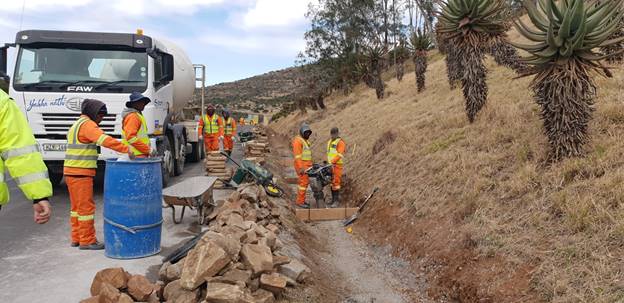SANRAL took ownership of the R67 from Grahamstown to Queenstown after it was declared a national road in 2012.

Periodic maintenance on the R67 between Fort Beaufort and Seymour in the Eastern Cape is improving road safety for pedestrians and motorists.
The 14-month road maintenance project by the South African National Roads Agency (SOC) Limited (SANRAL), valued at R151-million, which commenced last year, is helping to create safer travel experiences for motorists.
This road connects the towns of Fort Beaufort and Seymour and is a vital link between Fort Beaufort and Queenstown.
Mbulelo Peterson, SANRAL Southern Region Manager, said: “The installation of guard rails in the high fills as well as the construction of the Baddafort intersection has helped to improve the safety of the road. The stretch of the road was also fenced to prevent animals from crossing the road. This has made a significant change and has helped reduce the number of accidents on the road.”
SANRAL took ownership of the R67, from Grahamstown to Queenstown, after it was declared a national road in 2012. As part of its mandate, SANRAL is responsible for maintaining this important road.
The average daily traffic on this road ranges from between approximately 600 and 700 vehicles per day in both the North and South directions, while the average percentage of heavy vehicles using this road is around 12.8%.
This means that approximately 89 trucks use the road in each direction every day.
SMMEs benefit
Thirty (30) SMMEs worked on the project and a total of 369 jobs were created.
“This was regarded as one of the most important road development projects in the area over the last three years since it created job opportunities for 369 people from the local communities,” Peterson said.
Nomfundo Maneli, a Seymour resident and worker at Zubra Cleaning Services and General Training said her role in the project was to erect fencing.
She worked on the project for two months and during that period she had hoped to increase her CIDB rating to Level Two.
“We received training on safety and security before we started with the project, and the training taught me things that I thought I would never know,” Maneli said.
Lwando Solani, who lives in Seymour and is a construction worker at Solenzo Trading and Projects CC, worked on this project for three months.
Before working on the project, he received one-week training on the installation of guard rails.
“Since the maintenance I am happy to say that the road is now safe for pedestrians and motorists to use,” Solani said. After completing the project Solani’s CIDB Level 2 increased to CIDB Level 3.
Nolady Booi, the managing director at Azakhiwe Trading Enterprise and resident of Seymour, was responsible for stone pitching.
“We did the stone pitching in such a way that no water can come through,” Booi said. She worked on the project for two months thereafter her CIDB Level increased to Level 2.
Project scope
- Texture slurry from km 0.2 to km 40.8, both left-and-right-hand side.
- Scattered asphalt patching along the length of road up to km 40.8
- Rut filling on certain sections for ruts measured to be more than 20mm.
- Milling the last 1.2 km 180mm asphalt and base stockpiled to be re-used and 150 mm to in situ carted to spoil. The subbase was replaced by recycled stockpiled material. Imported G2 Base with a cape seal black top.
- Identified Targeted Enterprise works included: fencing, stone pitch, subsoil drains, concrete lined drains, gabions, concrete edge beams, kerbing and paving, bus bay platforms and construction of guardrails.
- Re-Sealing 40.8km of the road where 23km was a triple seal and the rest double.
Training and development
Target Enterprises (TEs) or Small Medium Micro Enterprises (SMME’s) who participated on this project had to be registered with the Construction Industry Development Board (CIDB).
They were given tender training, which was specific to their respective packages such as construction of stone pitching, installation of guard rails, erection of fencing and gabions.
This training included a five-day intervention on Tendering for Construction Contracts and two extra days were provided for SMMEs that required additional assistance.
“As a requirement for this project, it was important that tenderers were familiar with the specification that relates to the transformation of the construction industry and adhered to the policies of Reconstruction and Development programmes and other similar Government initiatives,” Peterson said.
The Target Enterprise Management Team provided guidance and mentoring to the prospective tenders and an accredited training service provider was organised to provide the necessary training.
SAQA accredited competency certificates and attendance certificates were awarded to the SMMEs.
Practical training was also organised for Targeted Enterprises (TEs). This included a two-day theory training and three-day practical skills training.
The training was for fencing, guardrails, gabion and stone pitching. All participants of the trainings attended that were deemed competent received SAQA accredited certificates.

